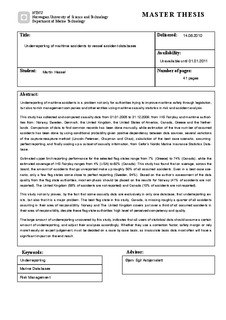| dc.description.abstract | Underreporting of maritime accidents is a problem not only for authorities trying to improve maritime safety through legislation, but also to risk management companies and other entities using maritime casualty statistics in risk and accident analysis.
This study has collected and compared casualty data from 01.01.2005 to 31.12.2009, from IHS Fairplay and maritime authorities from Norway, Sweden, Denmark, the United Kingdom, the United States of America, Canada, Greece and the Netherlands. Comparison of data to find common records has been done manually, while estimation of the true number of occurred accidents has been done by using conditional probability given positive dependency between data sources, several variations of the capture-recapture method (Lincoln-Petersen, Chapman and Chao), calculation of the best case scenario, assuming perfect reporting, and finally scaling up a subset of casualty information from Ceforʼs Nordic Marine Insurance Statistics Database.
Estimated upper limit reporting performance for the selected flag states range from 7% (Greece) to 74% (Canada), while the estimated coverage of IHS Fairplay ranges from 4% (USA) to 62% (Canada). This study has found that on average, across the board, the amount of accidents that go unreported make up roughly 50% of all occurred accidents. Even in a best case scenario, only a few flag states come close to perfect reporting (Sweden, 94%). Based on the authorʼs assessment of the data quality from the flag state authorities, most emphasis should be placed on the results for Norway (41% of accidents are not reported), The United Kingdom (56% of accidents are not reported) and Canada (10% of accidents are not reported).
This study not only proves, by the fact that some casualty data are exclusively in only one database, that underreporting exists, but also that it is a major problem. The best flag state in this study, Canada, is missing roughly a quarter of all accidents occurring in their area of responsibility. Norway and The United Kingdom covers just over a third of all occurred accidents in their area of responsibility, despite these flag state authoritiesʼ high level of perceived competency and quality.
The large amount of underreporting uncovered by this study, indicates that all users of statistical data should assume a certain amount of underreporting, and adjust their analyses accordingly. Whether they use a correction factor, safety margin or rely more heavily on expert judgement, must be decided on a case by case basis, as inaccurate basic data most often will have a significant impact on the end result.
Keywords: Maritime accidents, risk analysis, underreporting, accident statistics, capture-recapture. | nb_NO |
